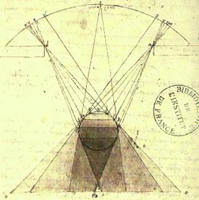|
|
IntroductionThese pages are extracted from the 2003 paper A survey of Real-Time Soft Shadows Algorithms. Cast shadows are crucial for the human perception of the 3D world. Probably the first thorough analysis of shadows was Leonardo Da Vinci’s48 (see Figure 1), focusing on paintings and static images. Also of note is the work of Lambert35 who described the geometry underlying cast shadows (see Figure 2), and more recently the paper from Knill et al.34.
With the emergence of computer graphics technology, researchers
have developed experiments to understand the impact of shadows on our perception of a scene. Through different
psychophysical experiments they established the important
role of shadows in understanding: Wanger49 studied the effect of shadow quality on the perception of object relationships, basing his experiments on shadow sharpness. Hubona et al.27 discuss the general role and effectiveness of object shadows in 3D visualization. In their experiments, they put in competition shadows, viewing mode (mono/stereo), number of lights (one/two), and background type (flat plane, «stair-step» plane, room) to measure the impact of shadows. Kersten et al.30, 31 and Mamassian et al.38 study the relationship between object motion and the perception of relative depth. In fact, they demonstrate that simply adjusting the motion of a shadow is sufficient to induce dramatically different apparent trajectories of the shadow-casting object. These psychophysical experiments convincingly establish that it is important to take shadows into account to produce images in computer graphics applications. Cast shadows help in our understanding of 3D environments and soft shadows take part in realism of the images. Since the comprehensive survey of Woo et al.52, progress in computer graphics technology and the development of consumer-grade graphics accelerators have made real-time 3D graphics a reality3. However incorporating shadows, and especially realistic soft shadows, in a real-time application, has remained a difficult task (and has generated a great research effort). These pages present a survey of shadow generation techniques that can create soft shadows in real time. Naturally the very notion of «real-time performance» is difficult to define, suffice it to say that we are concerned with the display of 3D scenes of significant complexity (several tens of thousands of polygons) on consumer-level hardware ca. 2003. |
|
Last update 03/2004 - Contact: |

